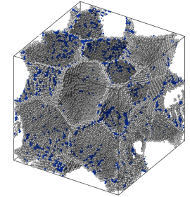One-shot free energy calculations for crystalline materials
T. Andersson
Master′s Thesis
(2012)
doi: 20.500.12380/158974
Download PDF

Current methods for free energy calculations in materials science are either computationally expensive, as λ-integration, or based on the harmonic approximation and thus only applicable to materials with stable lattices. Thus, a computationally cheap yet highly accurate method with broad applicability is sought after.
The objective of this thesis is to establish a method for one-shot free energy calculations utilizing effective harmonic models, obtained by fitting forces from molecular dynamics simulations. This approach enables extraction of effective harmonic representations of fully anharmonic crystals at finite temperatures. In addition, residual corrections to the free energy are incorporated using free energy perturbation.
Three systems are considered, titanium, iron and a dimer. The dimer is studied to highlight general features of harmonic models, whereas iron is considered as a robust test system for verification during method development. Finally, titanium is used as an example for a system with a rich temperature-pressure phase diagram featuring several entropically stabilized phases. λ-integration and velocity auto-correlation functions serve as reference methods for comparison of the free energy and phonon properties, respectively.
Excellent agreement with reference methods is reported for phonon dispersion and free energy in iron. For titanium the approach successfully reproduces the temperature dependence of soft modes. The resulting free energies exhibit larger deviations from the reference data than in iron. An improvement in this work compared to a similar approach recently published is the reduction of the number of parameters enabled by using symmetry properties directly during force matching and the application of free energy perturbation.
The proposed model requires only one simulation whereas λ-integration requires typically on the order of ten simulations. Hence, the proposed method reduces the total simulation time with a factor of 10. The approach outlined in this thesis enables accurate free energy calculations for arbitrary crystalline materials at a greatly reduced cost. It is therefore ideally suited for simulations based on electronic structure methods such as density functional theory.


